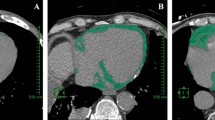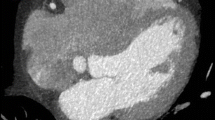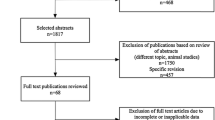Abstract
Objectives
To perform a systematic review of the growing body of literature evaluating the prognostic value of epicardial fat volume (EFV) quantified by cross-sectional imaging.
Methods
Two independent reviewers performed systematic searches on both PubMed and Scopus using search terms developed with a medical librarian. Peer-reviewed articles were selected based on the inclusion of outcome data, utilization of epicardial fat volume and sufficient reporting for analysis.
Results
A total of 411 studies were evaluated with nine studies meeting the inclusion criteria. In all, the studies evaluated 10,252 patients. All nine studies were based on CT measurements. Seven studies evaluated the prognostic value of EFV unadjusted for calcium score, and six of these studies found a significant association between EFV and clinical outcomes. Seven studies evaluated the incremental value of EFV beyond calcium scoring, and six of these studies found a significant association.
Conclusions
The majority of studies suggest that EFV quantification is significantly associated with clinical outcomes and provides incremental prognostic value over coronary artery calcium scoring. Future research should use a binary cutoff of 125 mL for evaluation of EFV to provide consistency with other research.
Key Points
• Epicardial fat volume (EFV) has prognostic value for adverse cardiac events
• Establishment of standardized quantitative categories for EFV is needed
• Quantification of EFV could improve risk assessment with calcium scoring


Similar content being viewed by others
Abbreviations
- CAC:
-
Coronary artery calcium scoring
- CT:
-
Computed tomography
- EFV:
-
Epicardial fat volume
- HR:
-
Hazard ratio
- MACE:
-
Major adverse cardiac event
- OR:
-
Odds ratio
References
Iacobellis G, Ribaudo MC, Assael F et al (2003) Echocardiographic epicardial adipose tissue is related to anthropometric and clinical parameters of metabolic syndrome: a new indicator of cardiovascular risk. J Clin Endocrinol Metab 88:5163–5168
Kim BJ, Kim BS, Kang JH (2012) Echocardiographic epicardial fat thickness is associated with arterial stiffness. Int J Cardiol. doi:10.1016/j.ijcard.2012.06.013
Nakanishi R, Rajani R, Cheng VY et al (2011) Increase in epicardial fat volume is associated with greater coronary artery calcification progression in subjects at intermediate risk by coronary calcium score: a serial study using non-contrast cardiac CT. Atherosclerosis 218:363–368
Raggi P, Alakija P (2013) Epicardial adipose tissue: A long-overlooked marker of risk of cardiovascular disease. Atherosclerosis. doi:10.1016/j.atherosclerosis.2013.02.030
Stojanovska J, Kazerooni EA, Sinno M et al (2015) Increased epicardial fat is independently associated with the presence and chronicity of atrial fibrillation and radiofrequency ablation outcome. Eur Radiol. doi:10.1007/s00330-015-3643-1
Cheng KH, Chu CS, Lee KT et al (2008) Adipocytokines and proinflammatory mediators from abdominal and epicardial adipose tissue in patients with coronary artery disease. Int J Obes (Lond) 32:268–274
Mahabadi AA, Berg MH, Lehmann N et al (2013) Association of epicardial fat with cardiovascular risk factors and incident myocardial infarction in the general population: the Heinz Nixdorf Recall Study. J Am Coll Cardiol 61:1388–1395
Mazurek T, Zhang L, Zalewski A et al (2003) Human epicardial adipose tissue is a source of inflammatory mediators. Circulation 108:2460–2466
Rosito GA, Massaro JM, Hoffmann U et al (2008) Pericardial fat, visceral abdominal fat, cardiovascular disease risk factors, and vascular calcification in a community-based sample: the Framingham Heart Study. Circulation 117:605–613
Spearman JV, Meinel FG, Schoepf UJ et al (2013) Automated Quantification of Epicardial Adipose Tissue Using CT Angiography: Evaluation of a Prototype Software. Eur Radiol. doi:10.1007/s00330-013-3052-2
Dey D, Suzuki Y, Suzuki S et al (2008) Automated quantitation of pericardiac fat from noncontrast CT. Invest Radiol 43:145–153
Tamarappoo B, Dey D, Shmilovich H et al (2010) Increased pericardial fat volume measured from noncontrast CT predicts myocardial ischemia by SPECT. JACC Cardiovasc Imaging 3:1104–1112
Janik M, Hartlage G, Alexopoulos N et al (2010) Epicardial adipose tissue volume and coronary artery calcium to predict myocardial ischemia on positron emission tomography-computed tomography studies. J Nucl Cardiol 17:841–847
Forouzandeh F, Chang SM, Muhyieddeen K et al (2013) Does quantifying epicardial and intrathoracic fat with noncontrast computed tomography improve risk stratification beyond calcium scoring alone? Circ Cardiovasc Imaging 6:58–66
Greif M, Leber AW, Saam T et al (2012) Determination of Pericardial Adipose Tissue Increases the Prognostic Accuracy of Coronary Artery Calcification for Future Cardiovascular Events. Cardiology 121:220–227
Cheng VY, Dey D, Tamarappoo B et al (2010) Pericardial fat burden on ECG-gated noncontrast CT in asymptomatic patients who subsequently experience adverse cardiovascular events. JACC Cardiovasc Imaging 3:352–360
D’Marco LG, Bellasi A, Kim S, Chen Z, Block GA, Raggi P (2013) Epicardial adipose tissue predicts mortality in incident hemodialysis patients: a substudy of the Renagel in New Dialysis trial. Nephrol Dial Transplant 28:2586–2595
Shmilovich H, Dey D, Cheng VY et al (2011) Threshold for the upper normal limit of indexed epicardial fat volume: derivation in a healthy population and validation in an outcome-based study. Am J Cardiol 108:1680–1685
Kunita E, Yamamoto H, Kitagawa T et al (2014) Prognostic value of coronary artery calcium and epicardial adipose tissue assessed by non-contrast cardiac computed tomography. Atherosclerosis 233:447–453
Britton KA, Massaro JM, Murabito JM, Kreger BE, Hoffmann U, Fox CS (2013) Body fat distribution, incident cardiovascular disease, cancer, and all-cause mortality. J Am Coll Cardiol 62:921–925
Bastarrika G, Broncano J, Schoepf UJ et al (2010) Relationship between coronary artery disease and epicardial adipose tissue quantification at cardiac CT: comparison between automatic volumetric measurement and manual bidimensional estimation. Acad Radiol 17:727–734
Mahabadi AA, Massaro JM, Rosito GA et al (2009) Association of pericardial fat, intrathoracic fat, and visceral abdominal fat with cardiovascular disease burden: the Framingham Heart Study. Eur Heart J 30:850–856
Saam T, Hetterich H, Hoffmann V et al (2013) Meta-analysis and systematic review of the predictive value of carotid plaque hemorrhage on cerebrovascular events by magnetic resonance imaging. J Am Coll Cardiol 62:1081–1091
Ding J, Hsu FC, Harris TB et al (2009) The association of pericardial fat with incident coronary heart disease: the Multi-Ethnic Study of Atherosclerosis (MESA). Am J Clin Nutr 90:499–504
Apfaltrer P, Schindler A, Schoepf UJ et al (2014) Comparison of epicardial fat volume by computed tomography in black versus white patients with acute chest pain. Am J Cardiol 113:422–428
Brinkley TE, Hsu FC, Carr JJ et al (2011) Pericardial fat is associated with carotid stiffness in the Multi-Ethnic Study of Atherosclerosis. Nutr Metab Cardiovasc Dis 21:332–338
Baker AR, Silva NF, Quinn DW et al (2006) Human epicardial adipose tissue expresses a pathogenic profile of adipocytokines in patients with cardiovascular disease. Cardiovasc Diabetol 5:1
Choi TY, Ahmadi N, Sourayanezhad S, Zeb I, Budoff MJ (2013) Relation of vascular stiffness with epicardial and pericardial adipose tissues, and coronary atherosclerosis. Atherosclerosis. doi:10.1016/j.atherosclerosis.2013.03.003
Min JK, Labounty TM, Gomez MJ et al (2014) Incremental prognostic value of coronary computed tomographic angiography over coronary artery calcium score for risk prediction of major adverse cardiac events in asymptomatic diabetic individuals. Atherosclerosis 232:298–304
Taylor AJ, Cerqueira M, Hodgson JM et al (2010) ACCF/SCCT/ACR/AHA/ASE/ASNC/NASCI/SCAI/SCMR 2010 appropriate use criteria for cardiac computed tomography. A report of the American College of Cardiology Foundation Appropriate Use Criteria Task Force, the Society of Cardiovascular Computed Tomography, the American College of Radiology, the American Heart Association, the American Society of Echocardiography, the American Society of Nuclear Cardiology, the North American Society for Cardiovascular Imaging, the Society for Cardiovascular Angiography and Interventions, and the Society for Cardiovascular Magnetic Resonance. J Am Coll Cardiol 56:1864–1894
Moher D, Cook DJ, Eastwood S, Olkin I, Rennie D, Stroup DF (1999) Improving the quality of reports of meta-analyses of randomised controlled trials: the QUOROM statement. Quality of Reporting of Meta-analyses. Lancet 354:1896–1900
Acknowledgments
The scientific guarantor of this publication is U. Joseph Schoepf, MD. The authors of this manuscript declare relationships with the following companies: UJS is a consultant for and receives research support from Bayer, Bracco, GE and Siemens. Dr. Nietert was funded by the National Center for Advancing Translational Sciences (Award Number UL1TR000062); the content is solely the responsibility of the authors and does not necessarily represent the official views of the National Center for Advancing Translational Sciences or the National Institutes of Health. The other authors have no potential conflicts of interest to disclose. The authors state that this work has not received any funding. One of the authors (Paul J. Nietert) has significant statistical expertise. Institutional Review Board approval is not required for a systematic review. Written informed consent is not required for a systematic review. Some study subjects or cohorts have been previously reported in the individual studies, which are summarized in this systematic review. The findings of the systematic review have not been previously reported. Methodology: retrospective, diagnostic or prognostic study, multicenter study.
Author information
Authors and Affiliations
Corresponding author
Rights and permissions
About this article
Cite this article
Spearman, J.V., Renker, M., Schoepf, U.J. et al. Prognostic value of epicardial fat volume measurements by computed tomography: a systematic review of the literature. Eur Radiol 25, 3372–3381 (2015). https://doi.org/10.1007/s00330-015-3765-5
Received:
Revised:
Accepted:
Published:
Issue Date:
DOI: https://doi.org/10.1007/s00330-015-3765-5




